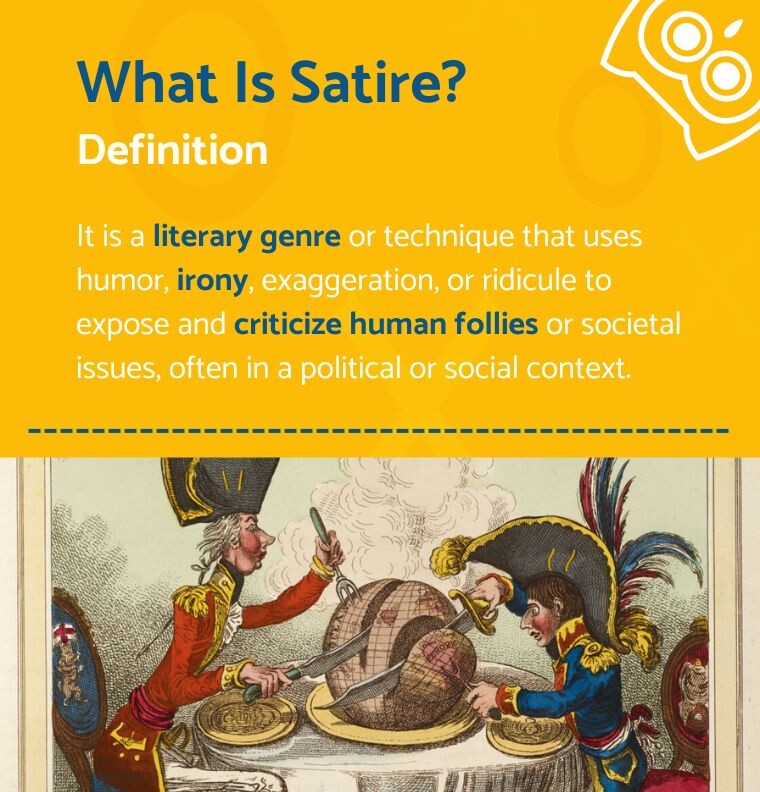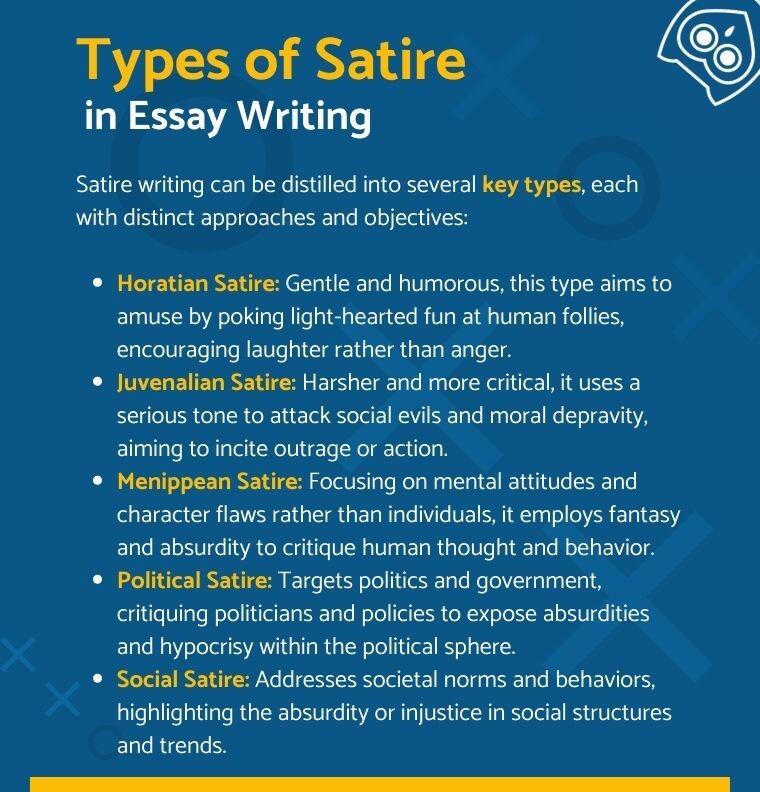Crafting Wit and Wisdom: A Guide to Satire Essay, Topics and Examples
Table of contents
- 1 Definition of satire and its historical background
- 2 Elements of a Satirical Essay
- 3 Choosing a Topic
- 4 Analyzing the Subject Matter for Potential Angles of Satire
- 5 Writing the Essay
- 6 What is a Satirical Essay: Examples of Satirical Essays
- 7 Fine Line Between Satire and Offensiveness
- 8 Concluding Thoughts: The Art of Writing the Satire Essay
In this insightful article, we delve into the realm of satire essays, a unique form of writing that blends criticism with humor.
Here’s what we’ll cover:
- Unveiling the essence of satire essay, its history, and types like Horatian and Juvenalian.
- Exploring the vital elements of a satirical essay, emphasizing a robust thesis, and the use of irony and sarcasm.
- Navigating the process of choosing engaging topics, including 50 hand-picked suggestions.
- Detailed guidance on structuring your satirical essay for maximum impact.
- Learning from examples of renowned satirical essays.
- Understanding the delicate balance between satire and sensitivity.
Join us as we explore these facets of satire essay writing, equipping you with the knowledge to create compelling, thought-provoking academic essays.
Definition of satire and its historical background

Satire, a literary genre known for its clever blend of humor and critique, has a rich history and diverse forms. Originating in ancient times, satire has been used to expose follies and vices in society, individuals, and institutions. The two main types of satire are Horatian and Juvenalian. Horatian satire, named after the Roman poet Horace, is characterized by a light-hearted and humorous tone, aiming more to amuse than to condemn. In contrast, Juvenalian satire, inspired by the Roman poet Juvenal, is more severe and abrasive, often expressing indignation and moral outrage.
The role of humor, irony, and exaggeration in satire cannot be overstated. These elements are tools for satirists to entertain, provoke thought, and challenge the status quo. For instance, exaggeration can highlight the absurdity of a situation, while irony can reveal contradictions and hypocrisies.
When considering topics for satire, it’s important to choose ones that resonate with the audience and remain relevant. Satire essay topics can range from light-hearted social commentary to more biting political criticism. The key is to select a subject that offers ample scope for humor and insightful critique. A satirical essay becomes an impactful tool for social commentary and change by selecting and handling these topics.
Elements of a Satirical Essay
A satirical essay is a unique fusion of humor and criticism woven to convey a thought-provoking message. Central to its success is a robust, clear thesis statement. This serves as the essay’s cornerstone, encapsulating the satirical argument. The thesis should be forthright and reflect the writer’s stance on the subject matter, whether it’s tinged with mockery, a critical edge, or a humorous slant.
The employment of rhetorical devices like irony, sarcasm, and parody is integral to the essence of a satirical essay. Irony stands out as a potent tool. It enables writers to express one thing while implying something else, often the opposite. This juxtaposition of the literal and the intended meaning adds layers to the satire, enriching its impact. Sarcasm, a variant of verbal irony, is adept at mocking or expressing disdain. On the other hand, parody involves imitating a subject or style to expose its flaws and absurdities.
A satirical essay is a clever blend of humor and critique, anchored by a clear, strong thesis and brought to life with the strategic use of rhetorical devices like irony, sarcasm, and parody. The choice of topic is crucial, as it needs to lend itself to satirical treatment, allowing the writer to lampoon the subject while engaging and enlightening the reader.
Choosing a Topic
The best topics for a satirical essay are those that resonate with your audience and remain relevant over time. Current events, social behaviors, and cultural phenomena are fertile grounds for satire. While choosing, consider what things to write a satire about that would engage and provoke thought in your readers. The effectiveness of your satire will depend on the relevance and universality of the topic selected.
When considering satire ideas, the topics should be chosen for their potential to be viewed through a satirical lens. This could involve turning a critical eye on societal norms, political policies, or even everyday absurdities. Funny satire topics revolve around current events, popular culture, or universal human behaviors, offering a wealth of material for insightful yet humorous critique.
Satirical essay ideas should aim to entertain, provoke thought, and encourage reflection. Topics to satirize can range from the mundane to the controversial, each offering a unique opportunity to highlight inconsistencies, hypocrisies, or the humorous side of life.
Here are some current and timeless topics that work well for satirical essays.
- The Perpetual Pursuit of the Perfect Body Image
- The Digital Detox: Escaping Social Media’s Grip
- The Billionaire Space Race: A New Playground for the Rich
- Fast Fashion Frenzy: The Race to the Bottom of Your Closet
- The Automation of Everything: When Robots Take Over Daily Tasks
- The Evolution of the Coffee Culture: From Bean to Obsession
- The “Influencer” Lifestyle: Reality vs. Instagram
- The Political Tug-of-War: A Satirical Look at Partisan Politics
- The Self-Help Paradox: More Books, Less Clarity
- The Tech Disconnect: Smartphones and the Illusion of Connection
- The Art of Procrastination in the Digital Age
- The College Admissions Arms Race: A Game of Prestige and Pressure
- The Corporate Buzzword Bingo: Synergy, Leverage, and Disruption
- The Quest for Immortality: Silicon Valley and the Fountain of Youth
- The Satire of Surveillance: Living in a Panopticon
- The Cult of Productivity: Doing More, Enjoying Less
- The Modern Dating Scene: Swiping Left on Romance
- The Vegan Revolution: Meatless Mondays and Beyond
- The Age of Misinformation: Navigating a Post-Truth World
- The Gig Economy Grind: Freedom or Freelance Frenzy?
- The Generation Gap: Baby Boomers vs. Millennials vs. Gen Z
- The Reality TV Paradox: Fame, Fortune, and Fabrication
- The Luxury of Minimalism: Spending More to Have Less
- The Endless Streaming Cycle: From Binge-Watching to Burnout
- The Battle Against Aging: Creams, Serums, and Unrealistic Expectations
- The Festival of Fads: Detoxes, Cleanses, and Other Health Mysteries
- The Tyranny of the Tidy: Marie Kondo and the Quest to Declutter
- The Irony of Connectivity: Lonelier in a More Connected World
- The Mirage of the “Perfect” Family on Social Media
- The Paradox of Choice in the Modern Consumer Society
- The DIY Disaster: When Pinterest Dreams Face Reality
- The Pursuit of Happiness Through Retail Therapy
- The Sacred Rituals of the Morning Routine YouTube Gurus
- The Mock Election: Satirizing Political Campaign Promises
- The Superhero Syndrome: The Oversaturation of Comic Book Movies
- The Great Organic Odyssey: Is It Really Better?
- The Exotic Pet Epidemic: From Tigers to Tarantulas
- The High Seas of Hobby Collecting: From Stamps to Sneakers
- The Dystopia of Driverless Cars: Are We There Yet?
- The Parable of the Paperless Office: More Paper Than Ever
Analyzing the Subject Matter for Potential Angles of Satire
Once you’ve selected a topic, the next step is to analyze it for satirical potential. Begin by identifying the subject’s inherent absurdities, hypocrisies, or contradictions. This critical examination allows you to uncover potential angles for satirical commentary. For example, in political satire, you might focus on discrepancies between a politician’s words and actions. In cultural satire, you could highlight the extremes of societal trends. This stage is vital as it sets the foundation for your satirical approach, shaping the direction and tone of your essay.
Remember, the goal is to provoke thought and discussion by presenting familiar issues in a new, humorous light. Your analysis should strike a balance between humor and insight, ensuring that your satire resonates with the audience while offering a fresh perspective on the topic.
Writing the Essay
Writing a satirical essay involves a strategic combination of humor, criticism, and a well-structured satirical essay outline. Begin with an engaging introduction that captures the essence of your satire. This could include an anecdote, a surprising fact, or a bold statement setting your essay’s tone. The introduction should culminate in a clear, concise thesis statement that encapsulates your satirical stance.
As you move into the body of your essay, each paragraph should focus on a specific aspect or example of your topic. This is where you can showcase different types of satire, such as irony, exaggeration, or parody, to strengthen your argument. Use vivid and descriptive language to paint a clear picture for your readers. Incorporating real-life examples or referencing satirical essay examples can illustrate your points. Balancing humor with factual information is important, ensuring your essay is entertaining and informative.
Consider using various rhetorical strategies to enhance your satire when developing your argument. Techniques like hyperbole can exaggerate your topic’s absurdities, while irony can highlight contradictions and inconsistencies. Sarcasm can add a sharp edge to your critique. Remember, the goal is to provoke thought and encourage a deeper understanding of the subject matter through humor.
In the concluding paragraph, summarize the main points of your essay, reinforcing your satirical message. The conclusion should echo your thesis and leave a lasting impression on the reader. A well-crafted conclusion will tie all your ideas together, emphasizing the significance of your satire and its impact on the reader’s perception of the topic.
Throughout your essay, maintain a consistent tone and style. The best satire essays are those that blend wit with wisdom, using humor as a tool to shed light on serious topics.
What is a Satirical Essay: Examples of Satirical Essays

The satirical essay genre blends humor with incisive social commentary. This essay leverages wit to critique everything from political policies to societal norms, often revealing underlying truths in an entertaining and thought-provoking way.
A classic satire essay example is Jonathan Swift’s “A Modest Proposal,” a pinnacle of Juvenalian satire. Swift’s essay, known for its biting and ironic tone, suggests that the impoverished Irish could alleviate their financial woes by selling their children as delicacies to the wealthy. This preposterous idea is not a whimsical musing but a sharp indictment of the brutal British policies towards the Irish and a comment on the apathy of the Irish people to their own plight.
This essay is a prime illustration of how to start a satire essay. Swift adopts a grave and sincere tone to advance an absurd proposition. This stark contrast between his tone and the ludicrousness of his proposal accentuates the absurdity of the situation he critiques. This strategic use of irony, where the true intent is veiled behind an opposite statement, is common in satirical essays. It allows writers to deliver powerful critiques in an engaging and impactful manner.
Another form of satire is Horatian satire, deriving its name from the Roman poet Horace. This type of satire differs from the abrasive Juvenalian style. A more playful, lighthearted approach characterizes Horatian satire. It tends to poke fun at human foibles and follies without aiming to cause distress or provoke significant change. It’s a more subdued and humorous satire, intending more to amuse than agitate.
For authors drafting a satirical essay, the choice of satire type is vital. It should align with both the subject matter and the intended message.
By analyzing seminal works like Swift’s “A Modest Proposal,” writers can learn to employ satire, creating works that are not just humorous but also insightful and thought-provoking. Effective satire has the power to be an influential tool for social commentary and change, making it a valuable and enduring form of literary expression.
Fine Line Between Satire and Offensiveness
Navigating the delicate boundary separating satire from offensiveness is paramount. While satire wields the potential for profound impact, it teeters on the edge of insensitivity. Responsible satirists know their audience and the broader context, ensuring their work critiques without inflicting harm. When addressing sensitive subjects, a delicate equilibrium is required. Satire becomes a tool for enlightenment rather than alienation or offense, using humor to shed light on societal issues without causing undue distress.
Concluding Thoughts: The Art of Writing the Satire Essay
In summary, the art of satire is a powerful yet intricate tool, merging humor with sharp social observation. Its core objective is to question established norms and provoke self-reflection. To write an effective satire essay, one must balance insightful critique with an approach that avoids offending. This genre requires a delicate touch, using wit and irony to make a point. An essential aspect of crafting a satirical piece involves creating a well-structured outline that supports the satirical thesis while engaging the reader. The creators and consumers of satire need to appreciate its significant potential to influence and its inherent responsibility towards society. Satire is not a literary device but a call to use its capabilities with wisdom and consideration.






